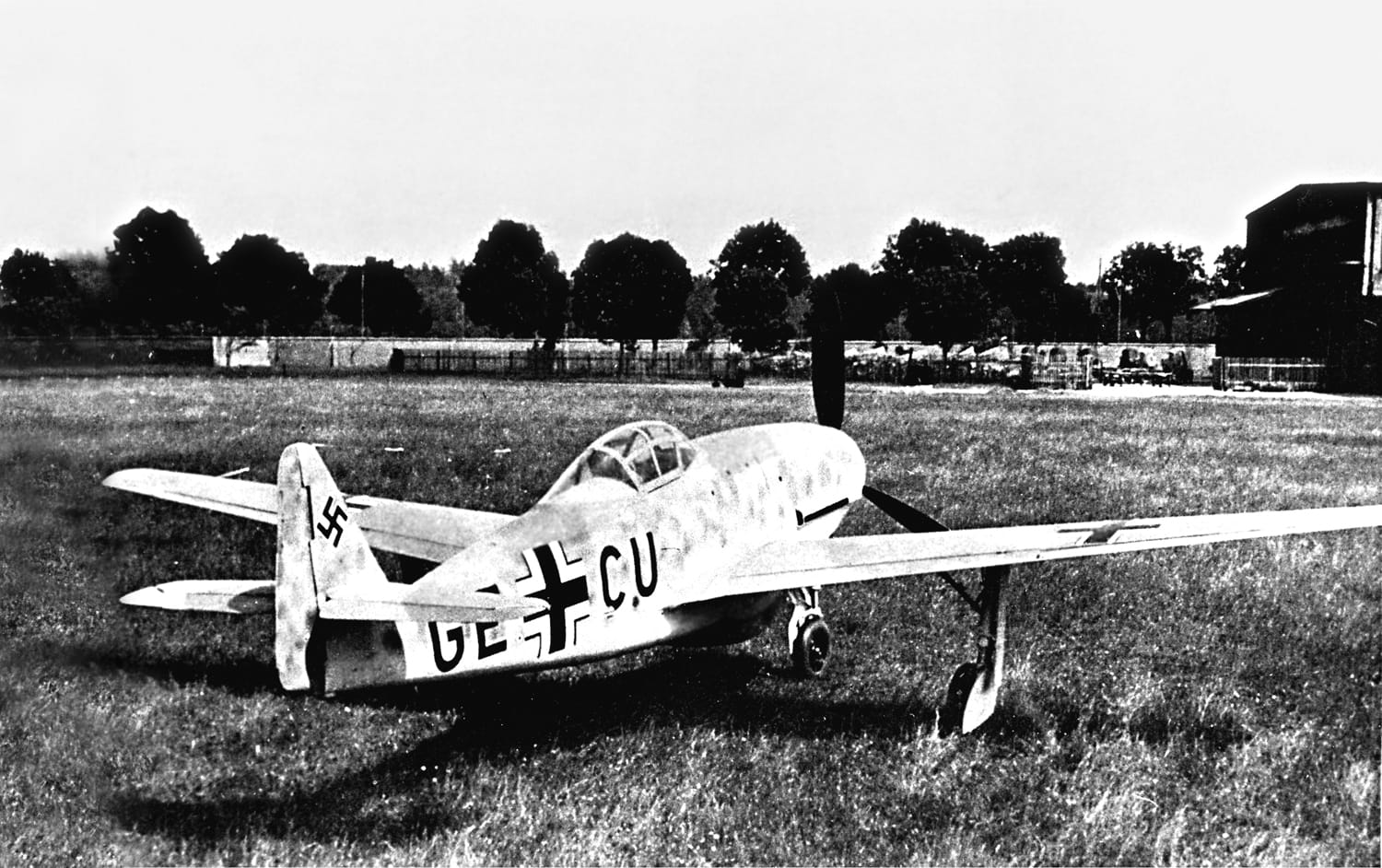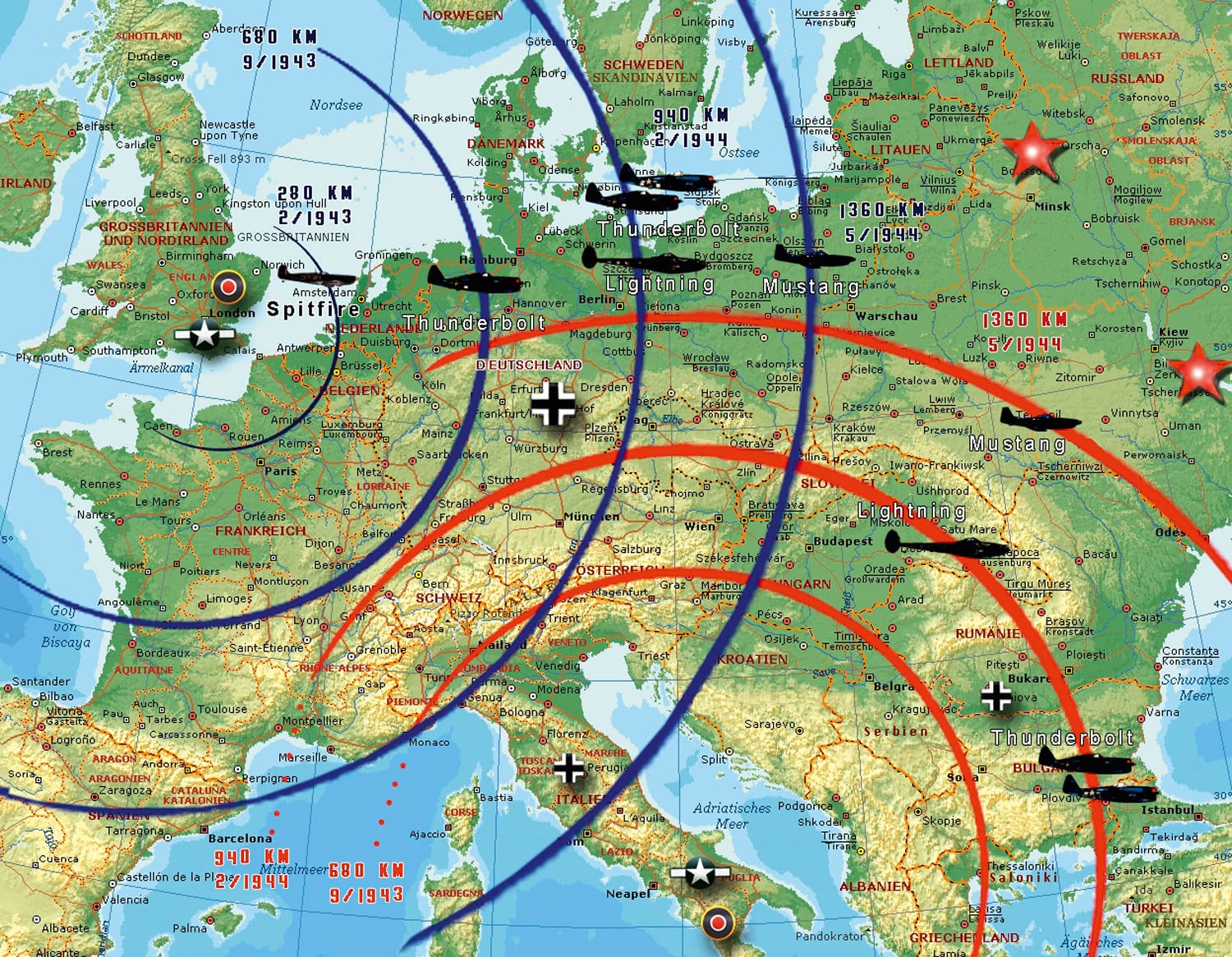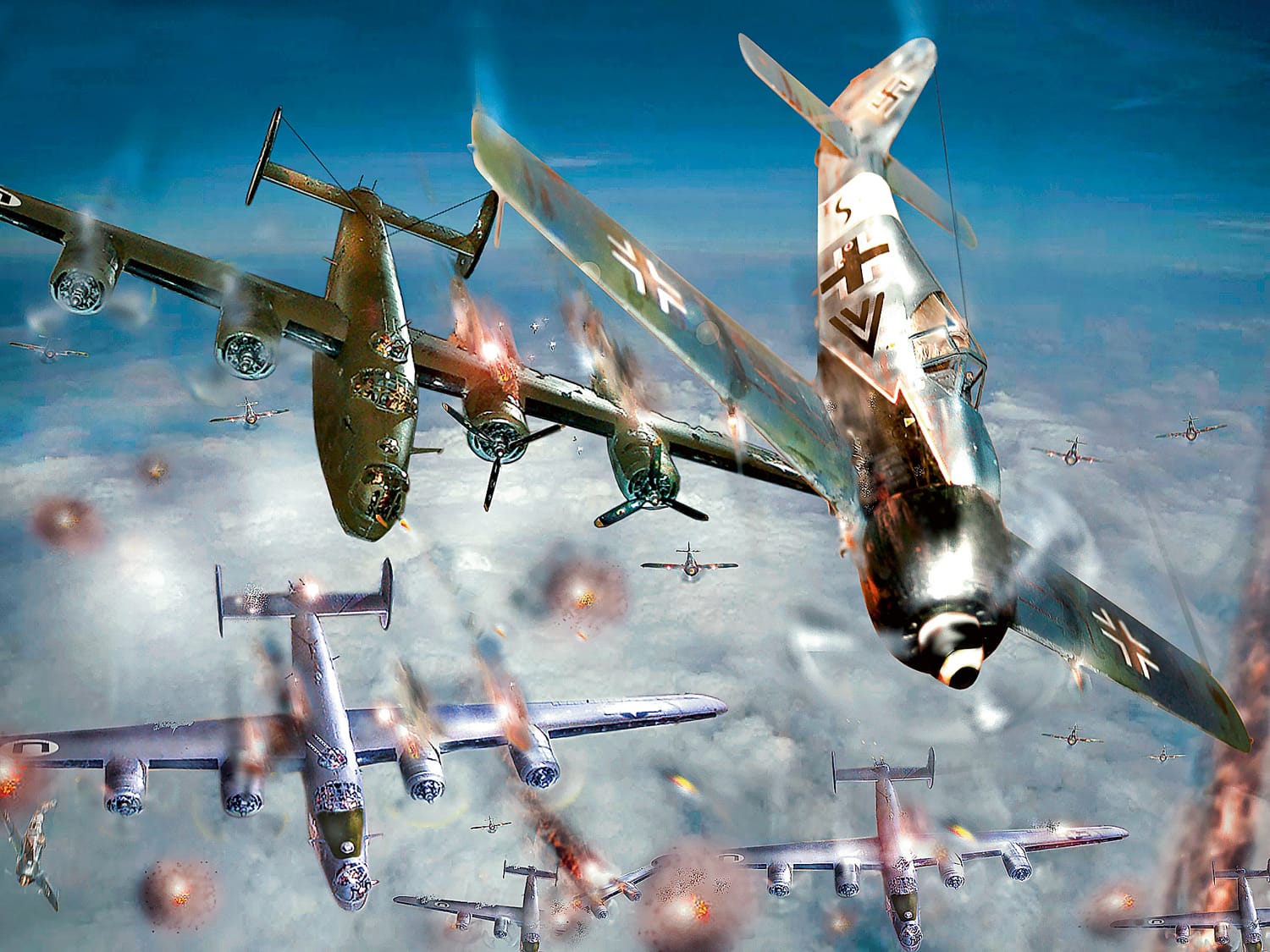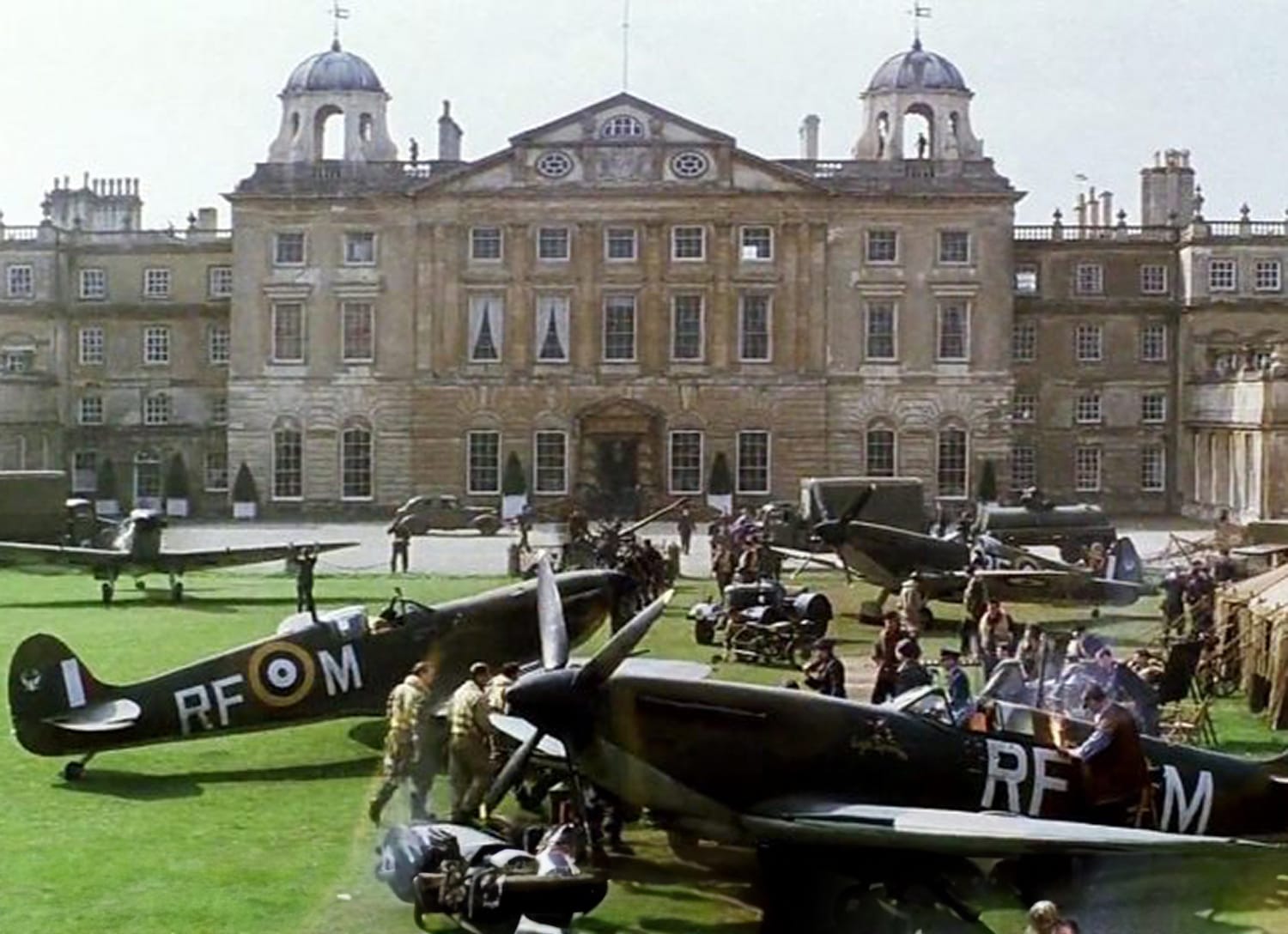The American escort fighters P-38 “Lightning”, P-47 “Thunderbolt”, P-51 “Mustang” and their range
P-38 “Lightning”, P-47 “Thunderbolt”, P-51 “Mustang”

Air combat through the ages: the challenges of the Messerschmitt Bf 109
In May of the year 1942, as the G variant of the Messerschmitt Bf 109 went into production, the basic design of the fighter aircraft was by now more than eight years old.
If the flight performance of the newer Focke-Wulf 190 had been better at altitudes above 20,000 feet than it was, then it would have spelled the end of the career for the Messerschmitt Bf 109. The latter’s rival was better balanced and much easier to fly. The harmonisation of its controls bordered on genius, and it was considerably better armed than the Messerschmitt. But above that altitude there was still a need for Willy Messerschmitt’s sleek model, in fact it became more pressing since the threat from the heavy American bombers became more pronounced. To say nothing of that posed by the fighter escorts covering those flying monsters. A Focke-Wulf 190 had its work cut out holding its own at those altitudes. Below 20,000 feet it had absolutely no difficulty.
The Messerschmitt Bf 109 competed with far greater distinction than the Focke-Wulf 190 at those altitudes, but the demand by the fighter units for an enhanced performance, heavier armament and longer flight duration in the defence against the American intruders was becoming ever louder. The more modern American fighter aircaft were in many respects simply superior, in fact dangerously superior, and at the moment their further development was increasing the allied advantage.
In Germany, therefore, a high pressure programme was launched to produce better, more powerful engines, so as to at least achieve the required increase in speed. With the more powerful armament of the Me 109 K variants, it was at long last possible to field the once again all-round competitive K-4 version. However, the airframe of the Messerschmitt Bf 109 had, in terms of design, long since reached the limits of its potential, gradually becoming obsolete, so that the increased power delivery of the more modern engines only to a limited extent reaped dividends with an increase of speed.
Call for innovation: the need for a new fighter aircraft
In order to optimise the engine’s performance they required a completely new fighter aircraft, and in order to develop one they needed:
- technical expertise.
- industrial capacity, in order to satisfy both the actual supply requirements for the model currently available, while at the same time readying a successor type for large scale production.
- the clear political prioritisation of a new design.
- and time.
Germany had at its disposal the undeniably outstanding design skills of its aircraft builders—but was lacking in all the other departments. It would take at least a year for the would-be successor of the 109, the Messerschmitt Me 309, which had taken off on its maiden flight on 29th November 1942, before it could go into mass-production. That was far too long to wait. The allied pressure was intensifying by the month. Germany needed fighters—and they needed them now!
Nevertheless, the Me 309 was a beautiful fighter aircraft with a wide tricycle undercarriage, with main wheels retracting inwards into the mainplanes, a nose wheel, and a teardrop cockpit canopy. Eventually production of the aircraft was abandoned in favour of the Messerschmitt Me 262.
The performance that a fighter aircraft built to a modern, aerodynamically optimised design could attain with a powerful engine, was clearly exemplified in the year 1944 by the North American P-51 Mustang.
There were even heated discussions at the very heart of the decision making process. The head of the technical division claimed that the speed of the Messerschmitt Bf 109 was completely satisfactory. However, its climbing performance needed to improve further, and its range was unsatisfactory. Willy Messerschmitt lost his temper. “What do you want“, he yelled at the official, “a fast fighter or a barn door?“
They could either build a fast, light, agile aircraft or a large, lumbering monstrosity that would be no more than a flying, long-range fuel tank: as simple as that!
The head of the technical division made a mental note of this harsh reprimand. Two years later the “lumbering monstrosities“ of the USAAF 8th Air Force would allow him sweet revenge for it, in purely rhetorical terms, that is.
These were the hefty, but still considerably fast American P-47 Thunderbolts, which were attacking ground targets deep inside enemy territory in the southern German city of Augsburg. It was here that Willy Messerschmitt’s design team had their headquarters, and he personally was running for cover with that same head of technical division. “There they go, those ‘barn doors’, you were on about!“, was the latter’s sarcastic put-down to the German aircraft designer.
Lockheed P-38 “Lightning”
The development of the Lockheed P-38 Lightning dates from the year 1937. The vast distances the US Air Force needed to cover, particularly in the Pacific, an area where it had bases to monitor from Hawaii via the Midway Islands as far as the Philipines, necessitated the production of a long-range escort fighter. Lockheed opted for the unconventional design of a twin-boomed aircraft with two engines. This design had the advantage of providing sufficient space for fuel tanks, but at the same time it had low aerodynamic drag and, therefore, low fuel consumption. A P-38 G-1-LO had a range of 850 miles without overload tanks. Dedicated interceptor fighters such as the British Spitfire or the German Me 109 had shorter endurance, the range of a Spitfire amounting to 429 miles. The P-47 Thunderbolt managed to surpass that, but with its two pressurised overload tanks the lower aerodynamic drag of the P-38, compared with the P-47, gave it the edge. When fitted with external fuel tanks at the end of 1943, the P-38 G-1-LO Lightning had a range of between 750 and 1,670 miles, depending on the altitude. In theory that was sufficient for a return flight of 835 miles. Realistically this was more like 600 miles, or from the south of England to Berlin. The modified P-38 J-25-LO, when equipped with two 300 (US-) gallon overload tanks in addition to its normal internal capacity of 410 (US-) gallons, finally achieved a maximum range of 2,260 miles, corresponding in theory to a combat radius of 1,130 miles, and in practice of some 750 miles. In early summer 1944 the J variant was the norm.
In direct combat with the single-engined interceptor fighters of the other side, the twin-engined fighters were initially unable to prevail, since although the single-engined enemy fighters were in general not that much faster, they were instead more agile and more manoeuvrable. This was the case in the early years of the war in the skies of Europe for both sides, for example, witness the poor achievements and in return the losses of the German Messerschmitt Bf 110 long-range fighter and the British Westland Whirlwind. In contrast to these dead end developments the Lightning, however, proved itself to be a rather successful fighter aircraft. It was as fast as the German fighters (by way of comparison, the Focke-Wulf Fw 190 A-8 had a top speed of 408 mph and the P-38 L Lightning had a maximum speed of 414 mph), but it was also surprisingly agile and its climbing performance was extremely competitive. Many of the German pilots were amazed at its capacity to turn on a sixpence and then abruptly to pull away into a very steep climb, while the twin Allison engines powered the American aircraft to such a speed that it made it difficult for the German fighters to pursue them. Furthermore, the Lightnings were very heavily armed with a 20 mm cannon and four 12.7 mm Browning machine guns, a fire power which led to the German infantrymen, who had such a hard time during the strafing attacks of the Lightnings, nicknamed the aircraft the “Gabelschwanzteufel“ (“fork-tailed devil“) out of grudging respect for it.
Nevertheless, a survey among German fighter pilot PoWs to find out which allied aircraft was the most feared and which one the least feared, revealed that the P-38 was the least feared enemy fighter aircraft. The aircraft’s performance and its kill tally did not corroborate this result, thus it was that many a Lightning pilot taught their enemy to fear it.
After the short cameo role of the first Lightnings in Britain in June/July 1942, which highlighted in particular the huge technical difficulties the Allison engine experienced with the damp British climate (and ultimately never fully eradicated), the P-38 Lightnings were flown to Algeria to support the American landings there (Operation Torch). It was here that the first heavy air battles took place with the Me 109s and Focke-Wulf Fw 190s of the German Afrikakorps stationed in Tunisia—and the first serious losses incurred by the still inexperienced Americans. Yet during the course of the war the number of experienced American pilots would continue to increase, whereas the number of experienced German pilots would steadily decrease. The P-38s reappeared in Britain from the end of 1943 and from there they saw action over France and Germany. In spite of their range it was still impossible for the P-38s to perform effectively their role as escort to the heavy American bombers deep into the heart of Germany. The aircraft suffered technical difficulties and there were too few of them operational. This accounted for the devastating losses of the USAAF over Schweinfurt on 17th August 1943. As the last American escort fighters turned away—predominantly P-47 C/D Thunderbolts—the first German fighters turned in. The turkey shoot of the bombers, which now continued their flight alone, was about to commence.
Of the 376 four-engined B-17 bombers present at take-off, the huge number of 60 were shot down. Another four were so badly damaged that they were written off, against “only“ 38 German fighter aircraft which were shot down. This was repeated on 14th October 1943—once again over Schweinfurt. Of the 320 bombers deployed, again 60 were downed and 145 damaged, and of these seven were write-offs, compared with 34 German (complete) losses. In the long term such a loss rate would be unsustainable for the Allies. The USAAF was forced to suspend their operations deep inside German air space. It was not until November 1943 that the P-38s of 20th FG and 55th FG were fully operational. On 3rd November 1943 the P-38 Lightnings of 55th FG escorted a bomber formation for the first time to a target—Wilhelmshaven—and then back home again. Admittedly that was not all that deep inside the German rear area. The first escort missions with P-51 Bs (354th FG) took place on 5th December 1943.Their first clash with the obsolescent German twin-engined Messerschmitt Bf 110 fighter aircraft occurred on 13th December 1943.
It was only at the beginning of 1944 that the situation radically altered when the P-38 J Lightning and the new P-51 B (from June 1944 the P-51 D) Mustang escort fighters, which were now equipped with technically improved overload tanks, could in fact fly with the bombers as far as Berlin.

Meanwhile, the P-47 D Thunderbolt now equipped with three overload tanks, had a vast combat radius as well.
In spring 1944 the significance of the P-38 diminished as the Mustangs began to appear in increasing number. Nevertheless, the Lightnings remained in action until the end of the war, operating over Germany and Austria out of Britain and France as well as Italy, often in the role of fighter bombers, but also as escort for the bombers.
While the German fighter pilots had more than enough opponents for their liking and some of them managed to achieve hundreds of kills—provided they survived that long—the American pilots were awarded the status of a fighter ace after only five confirmed aerial victories.
Fighter aircrafts and fighter bombers











Ebenfalls interessant…

The final kill of the ace of aces, Erich Hartmann, the most successful fighter pilot of all time
Dangerous encounter in the airIn March 1945 a Russian bombing attack on Prague was reported. Hartmann took off with four Me 109s. A Russian formation…
Weiterlesen
Sturmjäger – cuirassiers of the air
Air battle over Germany: the attack on hydrogenation plants and aircraft factoriesIn the early hours of the morning of 7th July 1944 756 B-17 Flying…
Weiterlesen
That’s how historic air battles get botched by Hollywood
Time and again the ignorance and nonchalance with which even highly renowned directors simply ignore historic details is fascinating. They do this in spite of…
Weiterlesen